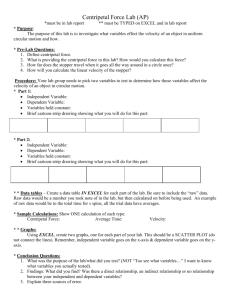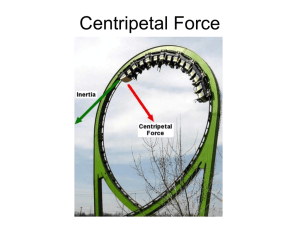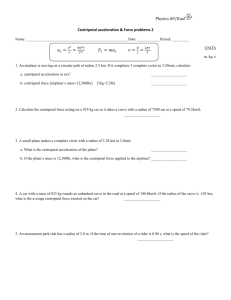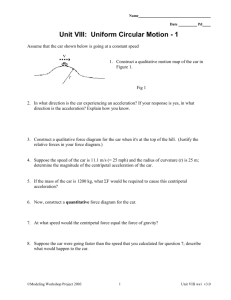Alenna Jamieson - Lesson Plan - Falling Mugs - esci300-2014
advertisement
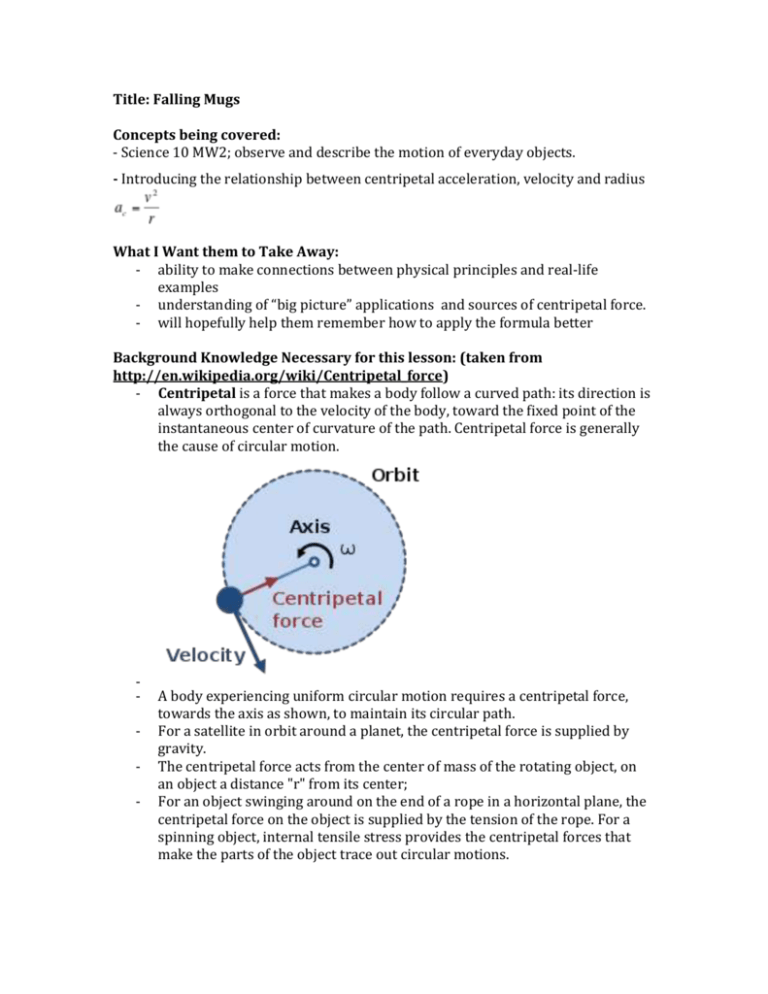
Title: Falling Mugs Concepts being covered: - Science 10 MW2; observe and describe the motion of everyday objects. - Introducing the relationship between centripetal acceleration, velocity and radius What I Want them to Take Away: - ability to make connections between physical principles and real-life examples - understanding of “big picture” applications and sources of centripetal force. - will hopefully help them remember how to apply the formula better Background Knowledge Necessary for this lesson: (taken from http://en.wikipedia.org/wiki/Centripetal_force) - Centripetal is a force that makes a body follow a curved path: its direction is always orthogonal to the velocity of the body, toward the fixed point of the instantaneous center of curvature of the path. Centripetal force is generally the cause of circular motion. - A body experiencing uniform circular motion requires a centripetal force, towards the axis as shown, to maintain its circular path. For a satellite in orbit around a planet, the centripetal force is supplied by gravity. The centripetal force acts from the center of mass of the rotating object, on an object a distance "r" from its center; For an object swinging around on the end of a rope in a horizontal plane, the centripetal force on the object is supplied by the tension of the rope. For a spinning object, internal tensile stress provides the centripetal forces that make the parts of the object trace out circular motions. Testing Prior Knowledge: (“Evaluate”) - Review quiz of the concepts and applications (ie in formulas) of acceleration, velocity, and distance in a linear motion (formative evaluation- quiz is not for marks but to identify prior knowledge) - Review quiz of forces acting on objects in a linear motion - Based on the results of the quiz, move on to this lesson or spend more time with the previously taught concepts of acceleration, velocity and distance Special Arrangements: Safety: Make sure students are far enough away from the mug demonstration that they won’t be injured by broken glass Demonstrator – must be wearing close toed, thick soled shoes and protective eyewear Identify the procedure for cleaning up the broken glass with the students. Explain not to pick up any broken glass, but sweep it up as soon as possible. Materials: Glass Mugs with handle Approx. 2 meters of string pencil Washers Students with smart phones or laptops, access to computers/wifi Type of Activity: Engage and Explore Script: First five (or more) minutes of class – -Ask students to recall some details about what we discussed last class -Administer quiz to test prior understanding of concepts involving acceleration, distance and time Falling mug activity (engage – teacher demonstrates, or has a student volunteer do it as well) - Have them take note of the relationship between length of string and and the motion (ie. the changes in speed) of the nut wrapping around the pencil. Make sure they know what they are supposed to be looking for! - Alternatively: Have them film it on their iPhones in slow motion and replay to the class, or have it pre-filmed on an iPhone and set up to show to the class in slow motion for better detail Explore: In groups of 2-3, have students explore (online, can use youtube videos) the following events: - figure skater spinning with her leg out and then when she/he brings her leg in - different planets circling the sun electrons orbiting an atom particles circling the large hadron collider coin dropper/spinner contraption in malls/public places top spinning Before sending them to explore, pose the question (and have them record their answers): What do all of these events have in common? Note*- All of these examples apply the principle of centripetal acceleration increasing as objects move closer to the center point in a circle Close lesson off with each group stating what they thought all of those events had in common. Identify the correct answer (objects in circular motion acceleration as they move closer to the center point) Last Five (or ten…) minutes of class: Exit Sheet (Evaluation) Introduce the following formula. (Don’t go into detail, it will be explained in the next lesson). Q: How do you think this formula connects to the events you observed in class today? Links to the Next Lesson: Use the responses from the exit sheet as a basis/starting ground to begin explaining the physics behind the formula in the next class and work on practical problems. Your Comments:

